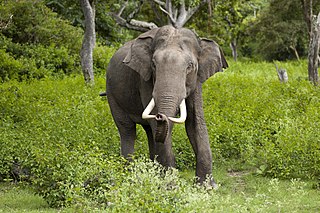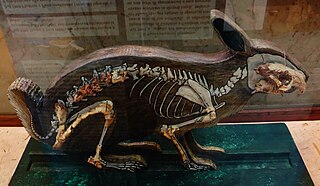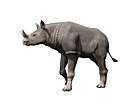
Hyenas or hyaenas are feliform carnivoran mammals belonging to the family Hyaenidae. With just four extant species, it is the fifth-smallest family in the order Carnivora and one of the smallest in the class Mammalia. Despite their low diversity, hyenas are unique and vital components of most African ecosystems.

Acinonyx is a genus within the Felidae family. The only living species of the genus, the cheetah, lives in open grasslands of Africa and Asia.

Elephantidae is a family of large, herbivorous proboscidean mammals collectively called elephants and mammoths. These are large terrestrial mammals with a snout modified into a trunk and teeth modified into tusks. Most genera and species in the family are extinct. Only two genera, Loxodonta and Elephas, are living.

The side-striped jackal is a canine native to central and southern Africa.

Chasmaporthetes, also known as hunting or running hyena, is an extinct genus of hyenas distributed in Eurasia, North America, and Africa during the Pliocene-Pleistocene epochs, living from 4.9 million to 780,000 years ago, existing for about 4.12 million years. The genus probably arose from Eurasian Miocene hyenas such as Thalassictis or Lycyaena, with C. borissiaki being the oldest known representative. The species C. ossifragus was the only hyena to cross the Bering land bridge into the Americas, and ranged over what is now Arizona and Mexico during Blancan and early Irvingtonian Land Mammal ages, between 5.0 and 1.5 million years ago.

Eucladoceros is an extinct genus of large deer whose fossils have been discovered across Eurasia, from Europe to China, spanning from the Late Pliocene-Early Pleistocene. It is noted for its unusual comb-like or branching antlers.
Ahl al Oughlam is an archaeological site and palaeontological site located just outside Casablanca, Morocco. It was discovered in 1985 and first excavated in 1989. Ahl al Oughlam is the richest late Neogene vertebrate locality of North Africa. It has also yielded the area's first important carnivore fauna, including 23 taxa, 13 of which are new.

Golunda is a genus of murine rodent.

Aeretes is a genus of squirrels that contains a single extant species, the groove-toothed flying squirrel (Aeretes melanopterus).

Acinonyx pardinensis, sometimes called the Giant cheetah, is an extinct felid species belonging to the genus Acinonyx, closely related to the cheetah, native to Eurasia during the Pliocene and Pleistocene epochs. It was substantially larger than the living cheetah.

Prolagus is an extinct genus of lagomorph. Over 20 species have been named, and the genus was abundant and widespread in Europe during the Neogene. However, by the end of the Middle Pleistocene, it was confined to a single species, the Sardinian pika, on the Corsica, Sardinia, and surrounding islands, where it survived into historical times. In North Africa and Western Asia, the genus is known from the Miocene and Pliocene. The scientific name may mean "before hares" or "primitive hares". Its taxonomy is disputed, with it either being considered a member of the family Ochotonidae, which includes living pikas, or the only member of the family Prolagidae.

The giant tapir is an extinct species of tapir that lived in southern China, Vietnam and Laos, with reports suggesting it also lived in Taiwan, Java, and potentially Borneo. The species has been recorded from Middle and Late Pleistocene. There is only weak evidence for a Holocene survival. Tapirus augustus was larger than any living tapir, with an estimated weight of about 623 kilograms (1,373 lb). The species was also placed in its own genus of Megatapirus, however, it is now conventionally placed within Tapirus.

Aceratheriinae is an extinct subfamily of rhinoceros endemic to Asia, Africa, Europe, and North America, from the Oligocene through the Pliocene. It lived from 33.9 to 3.4 mya, existing for approximately 30.5 million years.

Hypolagus is an extinct genus of lagomorph, first recorded in the Hemingfordian of North America. It entered Asia during the early Turolian and spread to Europe not much later, where it survived until the Middle Pleistocene. Though unknown in the Iberian Peninsula, fossils of this genus have been found in the Balearic Islands, suggesting an eastern migration during the dry period in the Mediterranean region known as the Messinian Salinity Crisis.

Stephanorhinus is an extinct genus of two-horned rhinoceros native to Eurasia and North Africa that lived during the Late Pliocene to Late Pleistocene. Species of Stephanorhinus were the predominant and often only species of rhinoceros in much of temperate Eurasia, especially Europe, for most of the Pleistocene. The last two species of Stephanorhinus – Merck's rhinoceros and the narrow-nosed rhinoceros – went extinct during the last glacial period.

Cervavitus is a genus of prehistoric deer that lived from the late Miocene to the Early Pleistocene in parts of Western and Eastern Europe, Central Asia and China.
Selenetherium is an extinct genus of elephantid proboscidean. The type and only species is Selenetherium kolleensis, known from an incomplete mandible. It was found in the early (Zanclean) Pliocene sediments of Kolle, Chad.

The Liushu Formation is a geological formation in Gansu province, China that spans up to 100 m thick and is widely distributed within the Linxia Basin, with a paleomagnetic age between 11 and 6.4 mya.

Pliorhinus is an extinct genus of rhinoceros known from the Late Miocene and Pliocene of Eurasia. The type species, Pliorhinus megarhinus, was previously assigned to Dihoplus.
Praesinomegaceros is an extinct genus of deer that lived in Eurasia during the Miocene and Pliocene epochs.



























